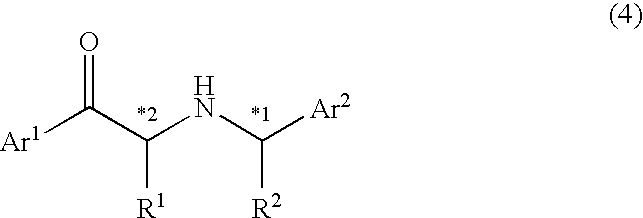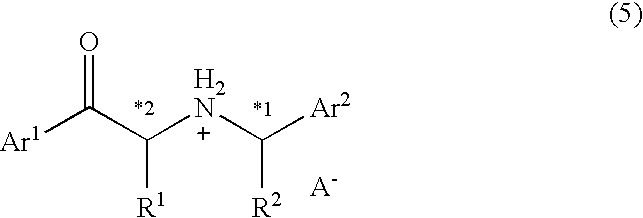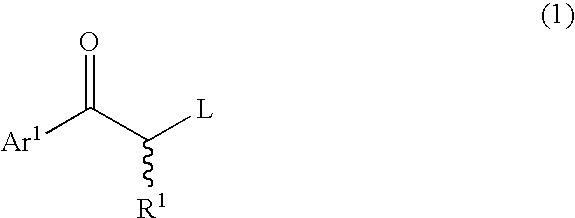Process for producing optically active beta-amino alcohol
a technology of beta-amino alcohol and production method, which is applied in the preparation of carbonyl compound, preparation by hydroxy group addition, and preparation of amino compound, etc., can solve the problems of inability to easily apply to synthesis of optically active 1-aryl-2-amino-1-ethanol derivatives having substituents in the benzene rings, and is not suitable for industrial applications. , to achieve the effect of being readily availabl
- Summary
- Abstract
- Description
- Claims
- Application Information
AI Technical Summary
Benefits of technology
Problems solved by technology
Method used
Image
Examples
reference example 1
1-[4-(benzyloxy)phenyl]-2-bromo-1-propanone
[0135] To 100 mL of a tetrahydrofuran solution of 24.00 g (100 mmol) of 4-benzyloxypropiophenone, a hexane solution (20 mL) of 23.973 g (1.5 equivalents) of bromine was gradually added at 20° C., followed by 1 hour of stirring. To the resulting solution, 50 mL of a saturated sodium hydrogen carbonate solution and 100 mL of ethyl acetate were added to conduct extraction. The organic layer was washed with 30 mL of a 20 wt % sodium thiosulfate aqueous solution, dried over anhydrous magnesium sulfate, and subjected to distillation under a reduced pressure to remove the solvents. A colorless, oily substance was obtained as a result. To this substance, 200 mL of hexane was added to precipitate crystals. White crystals (31.12 g; isolation yield: 95%) of 1-[4-(benzyloxy)phenyl]-2-bromo-1-propanone were obtained as a result.
Example of Synthesizing Optically Active α-Substituted Aminoketone (4) from α-Substituted Ketone (1)
example 1
Synthesis of (2R)-1-[4-(benzyloxy)phenyl]-2-[((1S)-phenylethyl)amino]-1-propanone
[0136] To an acetonitrile solution (20 mL) of 3.19 g (10 mmol) of 1-[4-(benzyloxy)phenyl]-2-bromo-1-propanone synthesized in REFERENCE EXAMPLE 1, 2.662 g (22 mmol) of (S)-1-phenethylamine was added, and the mixture was stirred for 4 hours at 40° C. After the solvent was distilled off under a reduced pressure, 30 mL of ethyl acetate and 20 mL of water were added to conduct extraction. The extract was washed with 20 mL of water, dried over anhydrous magnesium sulfate, and subjected to distillation under a reduced pressure to remove the solvents. An yellow, oily diastereomer mixture of 1-[4-(benzyloxy)phenyl]-2-[((1S)-phenylethyl)amino]-1-propanone was obtained as a result (reaction yield: 80%). The diastereomer ratio of this mixture was determined by high-performance liquid chromatography (column: YMC ODS-A A-303 4.6×50 mm, eluent: acetonitrile / 1 mM phosphoric acid buffer solution (pH=2.5)=1 / 1, flow: 0.5...
example 2
Synthesis of (2R)-1-[4-(benzyloxy)phenyl]-2-[((1S)-phenylethyl)amino]-1-propanone methanesulfonate
[0138] To an acetonitrile solution (20 mL) of 2.797 g (8.77 mmol) of 1-[4-(benzyloxy)phenyl]-2-bromo-1-propanone synthesized in REFERENCE EXAMPLE 1 and 1.775 g (2 equivalents) of triethylamine, 1.273 g (1.2 equivalents) of (S)-phenethylamine was added. The mixture was stirred for 16 hours at 40° C. To the mixture, 20 mL of water was added, and the solvents were distilled off under a reduced pressure. Extraction was then conducted while adding 30 mL of ethyl acetate. The organic layer was washed with 10 mL of a saturated sodium hydrogen carbonate solution, dried over anhydrous magnesium sulfate, and subjected to distillation under a reduced pressure to remove the solvents. An yellow, oily diastereomer mixture of 1-[4-(benzyloxy)phenyl]-2-[((1S)-phenylethyl)amino]-1-propanone was obtained as a result (reaction yield: 79%). Next, the mixture was mixed with 30 mL of ethyl acetate to prepar...
PUM
| Property | Measurement | Unit |
|---|---|---|
| Absolute configuration | aaaaa | aaaaa |
| Concentration | aaaaa | aaaaa |
| Volume ratio | aaaaa | aaaaa |
Abstract
Description
Claims
Application Information
 Login to View More
Login to View More - R&D
- Intellectual Property
- Life Sciences
- Materials
- Tech Scout
- Unparalleled Data Quality
- Higher Quality Content
- 60% Fewer Hallucinations
Browse by: Latest US Patents, China's latest patents, Technical Efficacy Thesaurus, Application Domain, Technology Topic, Popular Technical Reports.
© 2025 PatSnap. All rights reserved.Legal|Privacy policy|Modern Slavery Act Transparency Statement|Sitemap|About US| Contact US: help@patsnap.com



